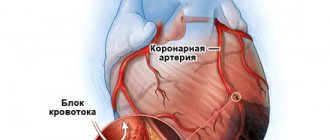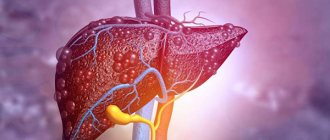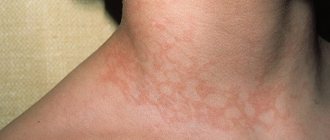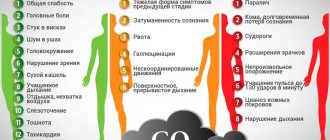These figures could be less frightening if the victims had time to receive professional, timely assistance.
To attract public attention to the problem, Red Cross and Red Crescent activists initiated the celebration of World First Aid Day. Traditionally, this holiday is celebrated on the second Saturday of September; this year it falls on the 12th. To support this event, we will talk about how to help someone who is fainting.
Types of loss of consciousness
Loss of consciousness is classified as an abnormal condition that is characterized by loss of reflexes and disturbances in the functioning of the nervous system. Develops when there is a small amount of oxygen caused by problems with blood circulation. Quite often, against the background of this condition, a deterioration in the functioning of all existing reflexes develops. Loss of consciousness is characterized by the fact that a person falls and does not move (an exception may be an epileptic seizure or muscle twitching), there is no reaction to various irritating elements.
General symptoms
In a state of twilight disorder of consciousness, whatever type it may be, contact with the patient is impossible, since he is detached from the real world, does not perceive it partially or completely. His consciousness suddenly seems to turn off. He is disoriented to varying degrees in the situation, time, people, place. His thinking process is disrupted, his judgments are incoherent or completely absent.
It is difficult to distinguish a sick person from a healthy person by appearance, since he behaves quite normally and is capable of performing quite complex actions. However, as soon as you begin to communicate with him, it immediately becomes clear that the individual cannot say either his own name, the names of loved ones, or the date where exactly they are. Although his speech may be correct from a grammatical point of view, he cannot carry on a conversation, he talks to himself, does not answer questions and does not expect an answer to his own.
The behavior is usually aggressive and poses a danger to others.
After emerging from such a state, the patient remembers poorly or does not remember at all what happened to him and what he did.
Fainting and loss of consciousness
The difference between these conditions is in the causes, provocateurs and consequences. Syncope is most often formed due to reversible disturbances in the supply of blood to cells, which are formed as a result of a sharp decrease in pressure.
Prolonged syncope, characterized by a prolonged lack of oxygen in the brain tissue, is based on severe organic disorders and provokes problems with vital functions.
| Parameter | Fainting | Syncope |
| Reason for formation | Problems with the nervous system, deterioration of blood supply to the brain against the background of a sharp drop in blood pressure | Diseases related to the functioning of the heart |
| Duration | A couple of seconds, but no more than five minutes | More than five minutes |
| Recovery speed | There is a rapid and absolute restoration of all reflexes, as well as physiological and neurological disorders | Recovery is slow and may not happen at all |
| Amnesia due to recent events, ECG changes | None | Present |
Causes and types
The causes of pathology are divided into two groups:
- organic - epilepsy, epileptiform syndrome, brain diseases, including tumors, damage to the medial temporal regions as a result of traumatic brain injury and a number of other conditions;
- functional - hysterical psychoses and narrowing of consciousness, affective states, unexpected situations with consequences in the form of severe psychological trauma.
There are twilight psychotic and non-psychotic disorders. The first include the following types, which have characteristic manifestations:
- Dysphoric twilight state of consciousness. A person acts in an orderly manner, he is self-absorbed, detached from the outside world, sad, does not respond to someone addressing him, or utters some stereotypical words that are not related to what the interlocutor is saying. The face is gloomy, even angry. Such patients can recognize familiar people and situations, but act inappropriately and are unable to critically evaluate what they are doing. Fleeting sensations of having a double, birth and death, etc. may arise.
- Delusional twilight disorder of consciousness. Delusional ideas are formed, and the patient’s behavior corresponds to their content. It seems to him that someone is pursuing him, wants to harm him, make him suffer, kill him. He is focused, behaves in an orderly manner, but normal communication with him is impossible. The patient’s actions are aimed at protecting against an imaginary threat dictated by delusion, most often antisocial. When the condition returns to normal, memories of the experience remain.
- Hallucinatory disorder is characterized by the presence of illusions and frightening visual and auditory hallucinations. Communication is impossible, since such a patient does not perceive reality and the appeal to him at all. He hums, pronounces or shouts individual words or phrases, most often inarticulate. As a reaction to terrible visions, aggression arises, the outbreaks of which result in very harsh actions performed with enormous force - beating, killing with bare hands or with the help of sharp objects.
A number of psychiatrists identify another type of psychotic twilight state of consciousness - oneiric. It is characterized by colorful fantastic or fairy-tale hallucinations, accompanied by catatonia - impaired motor functions, i.e. excitement or stupor.
Non-psychotic cloudings of consciousness include:
- Somniloquy - talking in your sleep.
- Somnambulism - sleepwalking, sleepwalking. Occurs in children and adolescents.
- Trances are long-term automatic actions. Most often, the patient leaves for another city.
- Outpatient automatisms are brief automatic actions. For example: a person leaves home, gets on public transport, and, upon waking up, finds himself incomprehensibly how and why in an unfamiliar place. The patient looks confused, thoughtful, there are no hallucinations or delusions. He does not remember at all what happened to him in a state of darkness.
- Genser's syndrome is a hysterical variant that occurs as a result of prolonged stress. The impetus for the development of the disorder is some kind of traumatic event, an unexpected exposure to unsafe, unusual conditions. The patient can only talk about these events, but he is not alienated from the world. The individual behaves like a clown, “falls into childhood” - he lisps, grimaces, and obviously answers simple questions absurdly. Knowing the purpose of things, he distorts their use, for example, he tries to pull gloves on his feet. Emotions suddenly change to the opposite. After an attack, the patient has fragmentary memories of what happened, which are restored after a good sleep.
The twilight state takes a person from reality to hallucinations. The latter replace a situation that was traumatic for him. Examples of darkness: amok - excitement, aggression and murder; the ritual of shamans - they introduce themselves into darkness and “infect” the participants in the action with it. An example can be given from literature - Lady Macbeth, the heroine of Shakespeare's tragedy of the same name, experiences a twilight episode in her sleep.
First signs
The following are signs that precede syncope:
- causeless anxiety, weakness, incessant yawning, heavy breathing;
- pale skin, sweating;
- headaches that bring a pressing or squeezing sensation, noise in the ears (ringing in the ears may be present), dizziness, hearing problems, suffocation;
- adrenaline rush, accompanied by heat at the end of the fingers;
- darkening before the eyes;
- tonic convulsions;
- a sharp increase or decrease in pressure, heart rate increases;
- nausea, vomiting, sour taste in the mouth.
Fainting is characterized by the presence of the following manifestations:
- the muscles are relaxed and the body is motionless;
- breathing slows down;
- blood pressure decreases;
- in case of deep fainting, the occurrence of convulsions and incontinence cannot be excluded;
- Pupils dilate, in the presence of serious pathologies, there is no reaction to light.
Recommended Actions
If you see a person starting to lose consciousness, try to prevent him from falling and hitting his head.
It is necessary to ensure a sufficient volume of blood flowing to the brain. What instinctive reaction occurs when a person loses consciousness? Of course, I want to help him. And if he is lying down, there is a desire to put something under his head, but this is extremely contraindicated in the condition described. The fact is that when you raise your head, blood flows out of it. Thus, a person needs to be laid so that his head is at least at the level of his body, and maybe lower.
You can raise your legs, and then the flow of blood from the limbs to the head will begin. Many people advise leaving the unconscious person alone, letting him lie down, and he will come to his senses. However, if patting the cheeks does not help, it is best to call an ambulance without leaving things to chance. The victim may need immediate medical attention.
Main pathologies
Syncope is caused by insufficient supply of ozone to the brain, which is usually caused by the presence of disturbances in the functioning of the body.
Vagal loss of consciousness
Most often they develop with spasms that narrow the nutrient vessels or with a decrease in pressure, and does not depend on severe pathologies of an organic nature. Some of the least dangerous causes of syncope include the following:
- stress (painful sensations or their expectations, the appearance of blood, an uncontrollable state of fear up to panic attacks, nervous overstrain);
- reflexes: coughing, sneezing, pain during urine excretion, penetration of a foreign object into the throat, problems with bowel movements, serious exercise;
- vegetative-vascular pathologies that develop during panic attacks.
After this condition, all functions are fully restored, but severe fatigue and panic attacks may be present.
Cardiogenic causes
The main factor causing syncope in 25% of cases is heart disease. After loss of consciousness occurs, it is immediately necessary to undergo a thorough diagnosis, since if this is not done, then a serious illness can be overlooked.
Most often, the factor that provokes insufficient oxygen supply to the brain and the formation of syncope in diseases of a cardiogenic nature is a decrease in the number of blood during cardiac output (blood pushed into the aorta during one contraction). As a rule, syncope is formed due to serious illnesses caused by disturbances in the heart rhythm (arrhythmia or tachycardia is detected, in which the heart rate is more than 160 beats per minute).
Loss of consciousness of arrhythmic type
This kind of syncope is caused by the presence of the following pathologies:
- Paroxysmal tachycardia is a sharp increase in the number of myocardial contractions per minute (more than 150).
- Ari – characterized by a high probability of cardiac arrest. It is quite difficult to identify such a pathology, since by the time the cardiogram is performed, the paroxysm has already disappeared, and such a false diagnosis as physiological fainting can be made. This does not reduce the likelihood of death.
- Weakening of the sinus node (poor functioning of the central node that controls the rhythm of the heart).
- Atrial fibrillation and gastric fibrillation.
- SVC syndrome is characterized by a pathological path of impulse conduction in the myocardium.
With this kind of disease, rhythm problems arise and the saturation of brain cells with blood is interrupted.
Other reasons
Other causes of insufficient cardiac output include the following:
- problems with the functioning of the ventricles;
- a heart attack that provoked problems with muscle contraction;
- congenital or acquired defects of the heart structure;
- vascular thrombosis;
- atherosclerosis.
With prolonged weak functioning of the coronary vessels, ischemia is formed (cell death occurs). Atrophy of the active fibers of the heart is observed; they are replaced by connective tissue, which is characterized by increased density and is unable to contract. There is a decrease in the output volume, the brain cells do not have enough oxygen, which causes a loss of syncope.
Shegarsky district 1936 - 2021
First aid is a temporary measure performed to save a life, prevent additional injury, and relieve suffering until qualified medical attention can be provided by specialists.
General rules
- Call “Ambulance” 03 or 103 (from your mobile phone).
- Make sure that neither the victim nor you are in danger.
- If possible, leave the victim lying where he is until he can be assessed. If you have to move it, do so with extreme caution.
- If the victim is vomiting, place him on his side to prevent suffocation.
- If the victim is not breathing, give him artificial respiration.
- Cover the victim to keep him warm and protect him from rain and snow.
- Bandage and secure the injured organ.
- Choose the most suitable transportation method.
Loss of consciousness
- Make sure the victim is unconscious.
- If he is unconscious, check to see if he is breathing.
- If he is not breathing, clear his nasopharynx. Pull his lower jaw forward. Tilt his head back so that his chin is higher than his nose. Pull his tongue forward so that it does not cover the nasopharynx.
- If the victim does not begin to breathe, use artificial respiration.
Stop bleeding
- Lay the victim so that the wound is above the level of the heart; if the wound is on the head or neck, raise the head and shoulders.
- Almost any bleeding can be stopped by applying several layers of clean cloth. Apply a bandage to the wound and tighten it tightly.
- If the bleeding continues, you need to press the artery to the bone above the wound: on the arm - in the middle between the elbow and armpit, on the leg - in the fold between the torso and thigh.
Stopping arterial bleeding (the most dangerous) by applying a tourniquet:
- make a tourniquet from a piece of fabric at least 5 cm wide (do not use rope, nylon, women's stockings, wire);
- place the tourniquet on the damaged part of the limb directly above the wound so that it does not slip when tightened;
- wrap the fabric twice around the surface and place one end of the fabric over the other, and then pass one under the other;
- take a short strong stick, place it across the half-knot on the fabric and tie both ends over the stick into a knot;
- turn the stick so that the tourniquet is tightened. Turn it until the bleeding stops;
- tie a piece of fabric around the stick and secure it around the limb so that the tourniquet is well secured.
A note is placed under the tourniquet indicating the date, hour and minutes of its application. The tourniquet can be used for 1.5-2 hours. Otherwise, the limb will die. During this time, the victim must be taken to a medical facility.
Penetrating chest injury
- If a bullet or sharp object has pierced the chest, a whistling sound is heard as it enters and exits, so that the lungs do not collapse, the hole must be closed. This can be done by hand, a plastic bag, adhesive tape or a clean cloth folded in several layers.
- Regardless of whether the victim is conscious or not, he is placed on his side with the injured side down.
Abdominal wounds
- Cover the wound with a clean cloth bandage. If intestines or other internal organs have fallen out, do not try to put them back in place.
- Place the victim in the most comfortable position. Place a folded blanket under your bent knees, this will reduce the pressure on the abdominal wall.
- Do not give the victim anything to drink, even if he asks for water. You should also not eat or smoke.
Electric shock
- Turn off the electrical current (handle electricity only with dry hands; never use electrical appliances on a wet floor, bench or table).
- If it is impossible to turn off the current, remove the contact wire from the victim with a safe object (it should be made of a material that does not conduct or poorly conducts electric current). A stick, folded newspaper, rubber-soled shoes, sneakers, clothes - all these items can be used if they are dry.
- Never touch the victim until you have turned off the power or removed the wire.
- See if the victim is breathing. Make sure your airway is clear. Use artificial respiration if necessary.
- If the victim is unconscious but breathing, place him in a safe position.
Burns
- Burns should only be irrigated with cold, clean water. Let it run for about ten minutes until the pain subsides.
- Never open a blister that has formed over a burned area of skin.
- Never remove pieces of clothing that are stuck to a burn.
- Apply a sterile bandage to the affected area of the body.
- Apply boric acid solution to burnt eyes (half a teaspoon of boric acid per 1 glass of water).
- Wrap the victim in a clean sheet, wrap him warmly, give him 2 analgin tablets to drink (if there is information about the absence of allergies), create peace.
- If the burn, covered with blisters, occupies an area larger than the palm of your hand, take the victim to a medical center or call an ambulance.
- Give the victim plenty of fluids: tea with sugar, fruit juice, water with salt diluted in it (2 teaspoons per 1 liter).
Frostbite
- The victim is brought into a warm room, the affected areas are wiped with alcohol (vodka) and rubbed with clean hands until the skin turns red.
- If a significantly larger area of the extremities is frostbitten, make a warm bath from a weak (pale pink) solution of potassium permanganate at a temperature of 32-36 ° C or apply heated objects.
- In case of general frostbite, the victim is warmed up as quickly as possible (brought into a room with a temperature of 20-22 ° C) and given hot tea, coffee, vodka.
Food poisoning
- Gastric lavage at home: the victim is given a large amount of water to drink (1-2 liters) and artificial vomiting is induced - placing fingers deep in the mouth, pressing on the root of the tongue. Then the procedure is repeated. In total, 10-12 liters of water are required to lavage the stomach.
- The last portions of rinsing water should be clear and free of food residues.
Fainting
- The victim is placed on a couch (head below feet) and given ammonia to sniff.
Sun and heat stroke
- The victim is placed in the shade and cooled - cold is applied to the head and heart area, and the skin is wiped with a wet towel.
- If you complain of pain in the heart, give validol or nitroglycerin under the tongue.
Help for carbon monoxide poisoning
Carbon monoxide (carbon monoxide - CO) is a product of incomplete combustion of organic substances. A highly toxic gas, colorless, sometimes with a burning odor. Leads the body to acute oxygen starvation.
Poisoning can occur in a fire, during the operation of gasoline engines, combustion of natural gas, etc. Death usually occurs as a result of CO poisoning in enclosed spaces with poor ventilation.
Poisoning, depending on the concentration of CO in the air, the duration of its exposure and the person’s condition, can be gradual or instantaneous.
Sudden loss of consciousness is possible, incl. and driving.
Signs of poisoning
- with a mild degree: the appearance of a feeling of heaviness and pulsation in the head;
- pain in the temporal region and forehead (“compression with a hoop”);
- darkening and flickering of “spots” in the eyes, tinnitus;
- dizziness, shallow breathing, increased heart rate, dilated pupils, increasing muscle weakness;
In the absence of help, shallow breathing, cardiac arrhythmia, dull heartbeat, convulsions and death of the victim are possible due to acute oxygen starvation.
First aid
- Take to fresh air and lay on your back.
- Unbutton your clothes and open your chest.
- Cool your face and chest with cold water, snow, ice.
- Wrap a rag soaked in cold water around your head.
If the victim does not come to his senses:
- make him sneeze, causing irritation in his nose;
- rub the victim’s chest with a mitten, scarf, or other object until breathing appears;
- perform artificial respiration;
- deliver the victim to a medical facility or call a doctor.
Diagnostic features
A patient with frequent occurrences of syncope is examined in the hospital using an ECG to refute or verify that such a condition is cardiac in nature. During the diagnosis, the following conditions are noted:
- If a patient is under forty years of age and has no abnormalities in the cardiac structure on the cardiogram, then syncope is most likely caused by the presence of neurological disorders.
- If a patient over forty years old has no lesions on the cardiogram, then the examination still begins with a detailed study of the condition of the heart.
In addition, you need to know the following:
- syncope caused by physical overexertion is not safe for people of any age group;
- the older the patient who experiences syncope, the greater the likelihood of having serious cardiac problems that caused this type of condition;
- if the duration of cardiac interruptions to the point of fainting is more than 5 seconds, then such interruptions are signs of serious heart disease;
- uncontrolled muscle twitching is quite often caused by temporary cerebral ischemia caused by the presence of heart disease;
- Even short syncope if a person has heart disease is usually considered a serious symptom.
It is especially dangerous if syncope is accompanied by the following factors:
- painful sensations behind the chest;
- in 60 seconds more than 160 heart contractions;
- heavy sweating;
- slow heartbeat;
- low pressure.
Treatment methods
For whatever reason a person loses consciousness, the first thing to do is call a doctor. But while the ambulance is on the way, you need to provide first aid to the victim. You need to act quickly and not panic.
What should you do if a person suddenly faints?
- The victim should be laid on his side and his head tilted back slightly.
- If necessary, remove tight clothing and splash cold water on his face.
- In the room, open all the windows and try to bring ammonia to your nose.
- It is advisable to raise the patient's legs or sit him down with his head bowed low.
- If a person has regained consciousness, under no circumstances should you allow him to get up quickly.
If it occurs due to a sharp drop in blood pressure, which is the most common cause, then the victim’s legs can be wrapped in an elastic bandage - this will disperse stagnant blood in the vessels.
In any case, an accurate diagnosis can be made by a doctor who will conduct an examination and prescribe the necessary treatment. The specialists of our center will provide you with qualified assistance!
Causes of deep fainting
A few words about deep fainting. This is a sudden loss of consciousness. Lack of blood flow to the brain contributes to poor metabolism and the supply of oxygen and glucose.
The reasons for this condition may be the following:
- Reduced blood flow to the brain can be a consequence of the following diseases:
- Arrhythmia.
- Heart failure.
- Impaired cardiac function during exercise.
2. Insufficient oxygen supply to the brain, or hypoxia. May occur in severe upper respiratory tract diseases.
3. A sharp decrease in blood glucose levels.
Deep fainting with loss of consciousness is very dangerous, as it can lead to oxidation of the brain.
If this happens, you should urgently consult a doctor and conduct a full examination of the body.
Prevention
What should you do or what should you worry about if you encounter such a problem? If fainting becomes more frequent, then, of course, first of all you need to consult a neurologist.
It is equally important to understand what conditions or situations lead to fainting. There are general tips that need to be followed. It has been noticed that most often fainting occurs in a stuffy room or in the open sun. It is important to avoid such situations. Drink as much water as possible, this will also prevent you from fainting. Therefore, everything is in your hands. Take care of yourself and your condition, and you will experience fewer unpleasant situations.
If you experience frequent fainting, you should consult a neurologist. Make an appointment in Chelyabinsk by calling 240-03-03 or on our website.
What is fainting?
Fainting is not a disease. It can be a symptom of some illness, and even then not always. This is just a sudden loss of consciousness as a result of reduced blood flow to the head. Consciousness is restored spontaneously.
Fainting can be:
- Epileptic.
- Non-epileptic.
After an epileptic episode, there is a very long period of time for the victim to return to normal.
Non-epileptic syncope includes:
- Convulsive. Normal fainting is accompanied by muscle twitching.
- Simple fainting.
- Lipotomy. Mild degree of fainting.
- Arrhythmic form. It happens with some types of arrhythmias.
- Orthostatic syncope. When there is a sudden change from horizontal to vertical position.
- Bettolepsy. Fainting that occurs during a period of chronic lung disease.
- Drop attacks. Very unexpected falls, while the person may not lose consciousness.
- Vasodepressor syncope. Happens in childhood.
Preventive actions
First of all, if you feel like you might lose consciousness, or this has already happened to you, you need to avoid such situations. Namely:
- Take medications in a timely manner if you have chronic diseases.
- Do not stay in stuffy rooms.
- Don't make yourself overly tired.
- Be able to control yourself in stressful situations.
- Don't go on strict diets.
- It is also not recommended to get out of bed abruptly.
- Avoid overexertion in the gym.
- Remember that feeling hungry can also lead to loss of consciousness.
To prevent fainting and loss of consciousness, it is recommended to follow a work-rest regime, exercise moderately, carry out hardening procedures, and eat in a timely and rational manner. If there are chronic pathologies, then it is necessary to regularly visit a specialist and undergo treatment for ailments.










